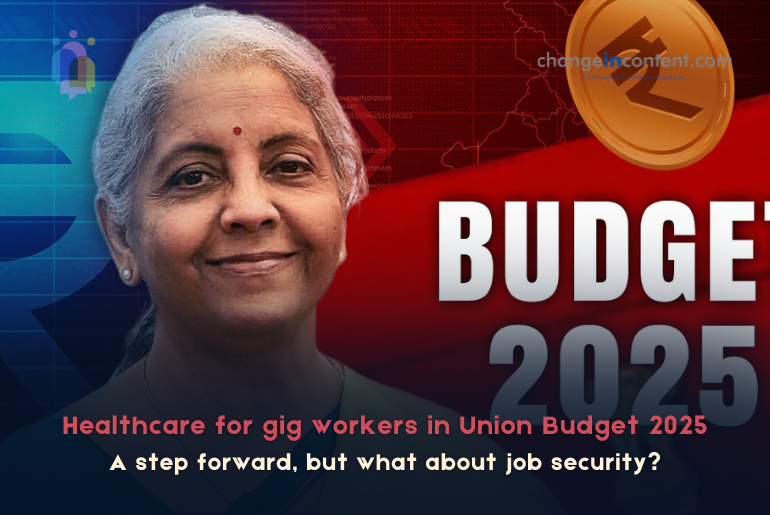The Union Budget 2025 marks a pivotal moment for the gig economy by extending healthcare for gig workers under the Ayushman Bharat Pradhan Mantri Jan Arogya Yojana (AB-PMJAY). While this move provides a layer of health security, the question remains—is it enough? With no income stability, accident coverage, or paid leave, gig workers remain vulnerable. A hospital bill may be covered, but what about lost income during recovery?
India’s gig economy includes low-, medium-, and high-skilled jobs, with most falling into the medium-skilled category. From food delivery on Swiggy and Zomato to ride-hailing via Uber and Ola, this sector includes any flexible or short-term work sourced through digital platforms.
The gig workforce is growing fast, especially with the rise of 10-minute delivery services. In 2023, Swiggy’s quick-commerce grocery service, Instamart, teamed up with job networking platform Apna to recruit over 10,000 gig workers from tier 2 and 3 cities. Zomato has its own grand vision of “empowering” one million gig workers by 2030. NITI Aayog’s report also states that the gig workforce will comprise 4.1% of India’s total workforce by 2029-30, which is roughly 23.5 crore people.
Yet, despite all this growth, gig workers remain in a precarious position. Unlike traditional employees, they lack job security, insurance benefits, and stable incomes.
Healthcare for gig workers: To be covered under PM-Jan Arogya Yojana
For years, gig workers have operated without financial stability or health security. Most of them are classified as independent contractors, which means they are not entitled to the same legal protections other workers are. So, if a delivery rider meets with an accident or falls ill, there’s often no employer-sponsored insurance to fall back on.
The Union Budget 2025 presents a notable step forward in addressing these issues. In a significant move for India’s gig labour welfare, Finance Minister Nirmala Sitharaman announced that gig workers will now be covered under the Ayushman Bharat Pradhan Mantri Jan Arogya Yojana (AB-PMJAY), the world’s largest health insurance scheme.
Gig workers can register on the e-Shram portal, receive identity cards, and gain access to PM-JAY healthcare. Thus, millions of gig workers who were previously excluded from employer-backed healthcare will get some coverage.
What does AB-PMJAY offer?
Launched in September 2018, AB-PMJAY provides free treatment up to ₹5 lakh per year for every eligible family. Managed by the National Health Authority (NHA), the scheme covers pre-existing conditions and offers immediate benefits without a waiting period. Initially, it covered 10.74 crore families but now extends to 14.74 crore families, benefiting nearly 70 crore people.
Gig workers, who often juggle unpredictable hours and physically demanding jobs, finally get some form of health security. Sitharaman herself stated, “Gig workers of online platforms provide great dynamism to the new-age services economy. Recognizing their contribution, our government will arrange for their identity cards and registration on the e-Shram portal. They will be provided healthcare under PM Jan Arogya Yojana. This measure is likely to assist nearly 1 crore gig workers.”
The union budget provides healthcare for gig workers, but is it enough?
While this scheme provides much-needed relief, it only addresses one part of the problem. Gig workers still lack income stability, accident coverage, paid leave, and retirement benefits. A health insurance policy won’t compensate for lost wages when a worker takes time off to recover. It also does nothing to protect them from sudden policy changes by the very platforms they depend on for work.
While working in the gig economy can provide you with more flexibility, there are also concerns regarding overtime entitlements. Moreover, these workers have no idea when or if they will get their next gig, causing financial instability. They are vulnerable to layoffs, pay cuts, and other job losses owing to economic fluctuations, the market, and individual companies.
And let’s not forget, while this initiative is a step forward, it costs gig employers nothing. Platforms like Swiggy, Zomato, Uber, and Ola still avoid providing direct benefits. They continue to call workers “partners” while maintaining complete control over their pay structures and working conditions. In fact, 77.6% of gig delivery workers in India earn less than ₹2,50,000 per annum. The government’s intervention helps gig workers to some extent, but it also allows companies to sidestep responsibility.
Healthcare for gig workers: The final thoughts
A hospital bill may now be covered, but what about lost income during recovery? Until gig work offers fair wages, job security, and formal labour rights, workers will continue to bear most of the risks. Health insurance is a start, but real change would mean ensuring that gig work isn’t just another way to shift corporate responsibility onto workers themselves. There is an urgent need for rights-based legislation that gives platform-based gig workers formal rights and social security.
Disclaimer: The views expressed in this article are based on the writer’s insights, supported by data and resources available both online and offline, as applicable. Changeincontent.com is committed to promoting inclusivity across all forms of content. We broadly define inclusivity as media, policies, law, and history—encompassing all elements that influence the lives of women and gender-queer individuals. Our goal is to promote understanding and advocate for comprehensive inclusivity.

